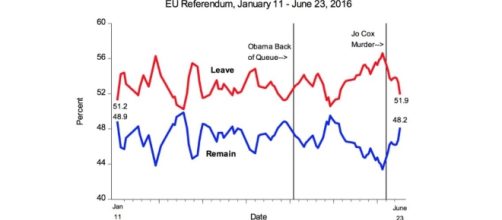Throughout the EU referendum there were many polls that had remain ahead, with many expecting remain to win. But leave won the vote. With the Brexit Bill passing through parliament without any amendments and the expectation that it will pass through the Lords with little opposition, there is a lot to learn from the vote about the state of UK politics and how pollsters measure their results.
Like the general election, where YouGov and many other pollsters predicting that there would be no clear winner. However, the Conservatives managed to win enough seats.
The Bayesian Theorem
There is however, one graphic that shows the correct outcome of the referendum. The graph in question shows the trend of voting intentions, with leave being ahead the entire time. The leave percentage even peaked at 57% but dramatically dropped after the murder of MP Jo Cox. The trends were estimated using Bayesian probabilities.
Bayesian probabilities is an interpretation of the concept of probability, named after Thomas Bayes, who was an English statistician, philosopher and Presbyterian minister. Instead of using frequency or propensity of some phenomenon, probability is interpreted as reasonable expectation representing a state of knowledge or as quantification of a personal belief.
Political trends
This highlights that pollsters need to find and use new methods to measure political trends, because they are becoming less reliable. With public trust in polls getting worse and the rise of fake news and misinformation. It is vital that the correct information is measured properly and published in the public eye.
The leave vote was a symptom of the current state of british politics with very little focus on local communities and with the by-election in Stoke-on-Trent Central, who voted in favour of Brexit, it’s a chance for them to protest over a feeling of being left behind by central government. No matter the result or what the polls say, the political state of British politics is a complete omnishambles.

